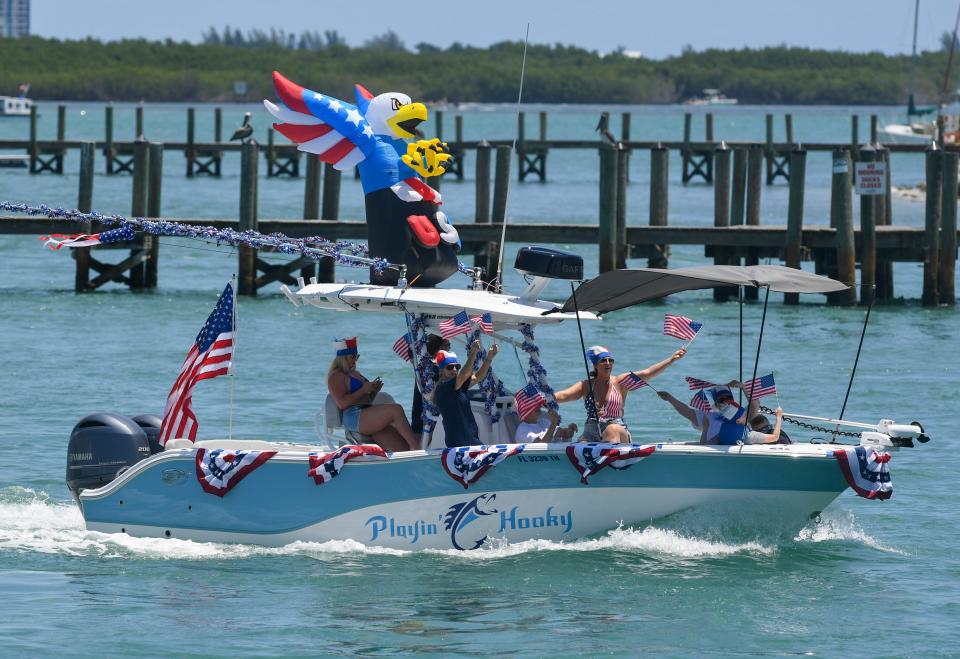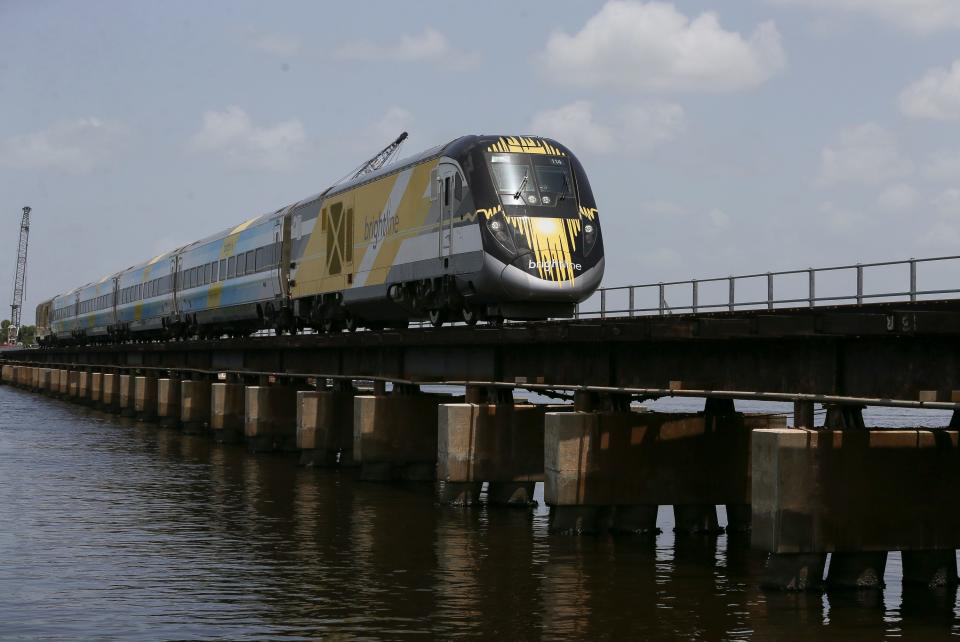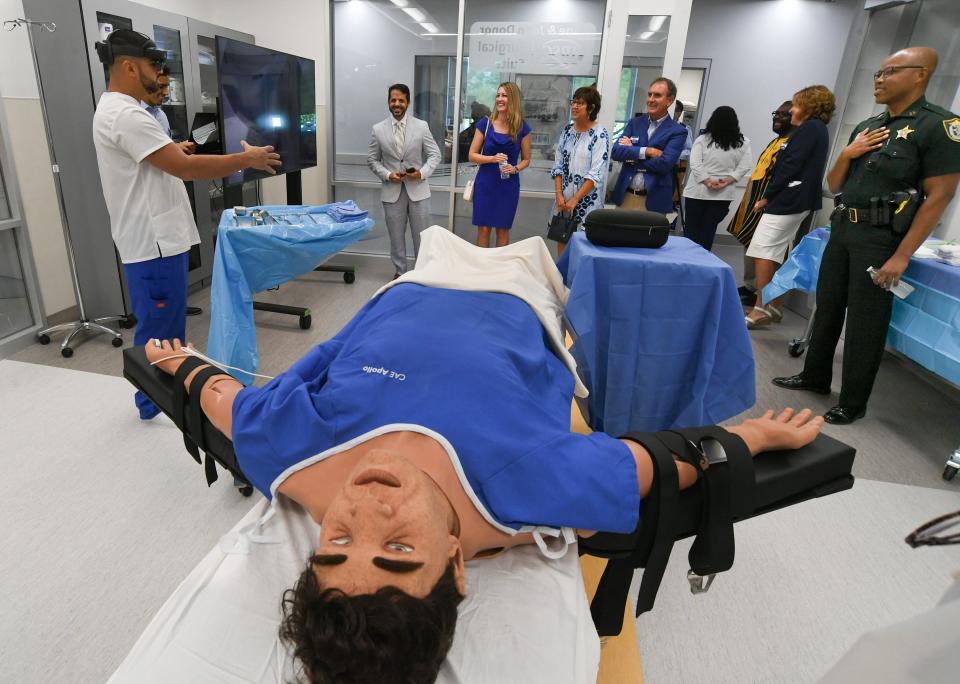Brightline deaths; Vero Beach airport; St. Lucie River woe; DeSantis, FAU; Trump | Letters
What I've learned from living 50 years near the St. Lucie River
I was 3 years old when we moved to Stuart. The St. Lucie River was a beautiful aqua color with green grasses flowing, teeming with life. We’d go clamming on Saturdays, and my father would make clams casino. You could almost guarantee you would catch a fish with just a few casts.
As water was released from Lake Okeechobee, we watched the river darken, and the birds became fewer. Each year, it was more difficult to catch fish. Soon, the grass died, and you could no longer see the bottom. Then came the smell, and it never went away.
It was easier to ignore the problem than to be responsible. After all, there was profit to be made. Everyone was too busy to worry about the environment. Banks were popping up on every corner and business was booming.
Aside from a wise few, no one wanted to worry about problems that might stifle our way of life. But those few wise voices still ring in my head. As a young boy living among retirees, I would listen. The wisdom of elders should always be trusted.
Now, 50 years later, living in that inevitable reality, I witness the same ignorance, incompetence and irresponsibility that plagued this community for decades and created this travesty. We have run out of fingers to point at others.
We look outside our community for answers and rely on the state and federal government to bail us out. Yet, we continue to over-develop. Our commissioners still recklessly approve zoning changes as if there are no repercussions. We still put revenue in front of ethical obligations and distort the line between right and wrong as we compromise our future, just as we have before.
Our recourses are finite, as was life in the river.
Nick Gulotta, Stuart
Could farmers' mystery shed light on watershed pollution?
The "forever" chemicals found in municipal water wells have mostly been reported as coming from firefighters practicing their trade by using foam fire retardant.
As farmers, we ran into a soil issue in Martin County on 300 of 3,000 acres we leased. When we first leased the land, this area was covered in matchweed, no grasses, only a few sedges. We tested the soil for fertility, turned and fertilized it, and planted brown top millet and Argentine Bahia. The millet came up great and we harvested the seed, but no Bahia.
The second year, we did the same treatment and got the same results (thinking we had some bad seed or it got drowned). Soil samples were sent to A&L Laboratories in California to test for everything. They came back with 500 times the level of normally occurring antimony.
We had never heard of this. Research told us that it was used in firefighting foam. How did that get on 300 acres?
From our ranching experience, we thought about sludge. We checked the Department of Environmental Protection records and, sure enough, hundreds of truckloads of sludge were spread on this parcel in the 1990s and 2000s. It was hauled out of Broward County. Evidently, someone was flushing it down the drain.
These tons of sludge spread on the ranchland make fireman practice (buckets) seam minuscule. I am sure this not an isolated instance and is probably common up and down the ranchland of the eastern marsh of Lake Okeechobee and the St. Johns River.
This would be the first place to get rid of sludge because of convenience and trucking cost. It evidently takes about 10 years for it to percolate down to the wellpoints. It would be interesting to test the soils and plants in these watersheds and review Department of Environmental Protection permits.
John Earman, Vero Beach
'Forever' chemicals: Stuart's desire for untainted water supply put city at odds with 3M in national lawsuit

More: Vero Beach airport adds service while Treasure Coast International eyes pie in the sky
Think now, before Vero Beach commercial air traffic outgrows welcome
With the airport expansion plans being discussed in Vero Beach, I have one question that has yet to appear in any of the articles I've read:
How will our residents be affected by the increase in flights over our small town?
With larger planes descending upon our community, how will noise levels and toxic air quality affect us? Will our quality of life be snuffed out to benefit tourism and so-called progress? For those living near or under the flight path, will those people be forced to accept a constant barrage of noise and interruptions to their once-bucolic lives here in paradise?
These questions need to be answered before we swallow this plan, hook, line and sinker.
With progress comes new challenges. Yet no one seems to have considered the impact this will have on our community.
I have lived in towns where increased flight traffic resulted in significantly negative impacts on neighborhoods. It's never a problem until it hits home, then all hell breaks loose.
For those local agencies promoting this expansion, I sure hope you're considering the impact these additional flights may have on our community. Today, the majority of flights take off directly over some well-established communities here in town. Are we simply going to ignore this issue and embrace Breeze Airways (and others) or are we going to study the flight expansion issue and make smart decisions that will better serve our tax-paying residents?
It's only a problem when it hits home. Smart growth is good thinking. So please, let's put on our thinking caps before it's too late.
John Ryan, Vero Beach

Overdevelopment, pollution? Blame voters, love of money
I am always amazed about citizens who want slow or controlled growth in their community, then proceed to elect individuals who benefit from this uncontrolled growth.
When was the last time any government council had a city planner, architect or landscape architect on the board? As for those on staff, they are most often ignored.
It’s criminal how, in a short time, Americans have turned a pristine country into a visually air- and water-polluted country. All for the love of money.
Anthony Frigo, Jensen Beach

Column reminiscent of old Union Pacific rail training
Laurence Reisman's opinion piece Aug. 9 really resonated with me. The key to avoiding incidents while crossing the tracks is public awareness and respect for the environment presented when near any railroad track.
In my first two weeks of employment, I attended a new hire brakeman training school as a management trainee. Early in the session, the instructor, a grizzled “old head” veteran conductor, took a poll. He asked all of us two questions: Do you think the railroad is a dangerous place? The next question was, do you think the railroad is a hazardous place? We all raised our hands yes to both queries.
His response sums up Reisman's column. Yes, the railroad is a hazardous place, but he then added it only becomes a dangerous place if you don’t recognize and respect the inherent hazards that you are being taught here. Public awareness is critical.
Driving an automobile also presents a potentially hazardous environment. We’re all taught to not run red lights at intersections. We’re all taught not to pass stopped school buses with flashing red lights.
The same is true of respecting the environment near any railroad track. The most technically modern crossing protection has been installed. It will greatly inhibit crossing accidents. Public awareness will take all of us from further reduction of incidents to prevention of them in the first place.
Woody Sutton spent 37 years in the operating department of the Union Pacific Railroad before retiring to Vero Beach.
Brightline deaths avoidable, but ...
Although I am no longer a seasonal resident of Vero Beach, I have watched the progress of Brightline from the hearings unitil now.
I am an engineer and have extensive experience with a rail project, although it was not high speed. I was a resident of Cohasset, Massachusetts, when the Massachusetts Bay Transportation Authority planned to restore commuter rail service through five towns south of Boston, including ours.
I volunteered to join the Town Mitigation Committee, whose function was to ensure the project had minimal impact on our historic town. I attended various project planning and permitting meetings.
When the project received permits to proceed, I was hired by the town as an intermediary between the town, the residents and the town administration. I have seen a rail project up close and personal.
Some safety items we negotiated:
Fencing along all populated lands.
Quad gates at all high-traffic crossings (four gates, each covering each lane, with a measure of traffic channelization. Where space permitted, concrete barriers, and when space was tight, vertical rubber separations, were used.
Each crossing had separate pedestrian gates.
With Brightline, Vero Beach has more than twice our 50-mph max speeds, with no fencing along the right of way. Even interstate highways are fenced.
Frequently, I read about deaths of pedestrians or vehicles able to gain access to the tracks. Fencing populated areas and better crossing protection could have eliminated almost all of these deaths.
I attended quite a few meetings with Vero Beach, the county and regulators, and I tried to impress upon them the criticality of adequate safety measures, but these mostly fell on deaf ears.
I am very sad when I read about another death.
Tom Gruber, Alpharetta, Georgia
Brightline: At-grade crossings could lead to 82 deaths a year
Since Brightline started running trips from Miami to West Palm Beach, its death rate is 1 per 35,000 miles traveled, according to the data I've found. Auto deaths in Florida are 1 per 1,600,000 miles.
Statistics show that when Brightline starts running 32 trips daily to Orlando, it will be projected to kill 82 people a year.
Most high-speed trains in the world have elevated crossings, while Brightline has none.
Jim Harter, Palm City

IRSC nursing program expansion first step in helping region
Maintaining a standard of exceptional health care is critical to the growth of Florida’s economy.
Attracting businesses and residents, retaining businesses and providing a vibrant quality of life hinge on the quality of our health care. Yet, according to the Florida Hospital Association, by 2035, the state will have 59,100 fewer nurses than it requires.
Nineteen months ago, I testified at a Florida Senate appropriations subcommittee on higher education’s response to the dire nursing shortage. I announced Indian River State College's bold commitment to double the capacity of our School of Nursing.
Recently, it was my honor to stand with our board of trustees, foundation board of directors, elected officials, former Senate President Ken Pruitt, community health care partners and IRSC administration, faculty and students to reveal the transformation of 50,521 square feet of space on our Pruitt Campus in Port St. Lucie in support of growing our regional nursing pipeline.
The expansion immediately increases student access to nursing careers and will double the number of IRSC nursing graduates by 2025. Further, the immersive, high-technology health care learning environments revolutionize the delivery of nursing education, producing ready-for-practice graduates trained on the latest and greatest in the clinical setting.
By investing in modern facilities and the finest faculty, IRSC demonstrates its commitment and adaptability as a critical workforce development resource. More students will progress to great-paying, high-demand careers. And with 95% of students staying in Florida post-graduation, the result is great for the state and our district.
IRSC is grateful for the support of our local legislative delegation, economic development and health care industry partners, and the investment by Gov. Ron DeSantis — all of whom have helped us move with velocity to deliver this leading-edge educational site.
This is the first step in transforming the IRSC Pruitt Campus into a comprehensive health and human sciences campus.
Timothy Moore is president of Indian River State College, based in Fort Pierce.
Nothing Fine about DeSantis' involvement in FAU presidency
Once again Gov. Ron DeSantis has abused the power of his office to delay the appointment of a new president for Florida Atlantic University.
Once he determined that his candidate of choice, personal ally and state Rep. Randy Fine, a candidate with no educational experience or leadership except as a student, did not make the finalist list, DeSantis seemingly ordered his self-appointed cronies to immediately suspend the search for a new president.
These actions would allow for a new selection process to begin, and anyone with any modicum of intelligence knows what the outcome will be. This outcome, unless stopped by enlightened voters, will be that DeSantis will be allowed to personally choose a candidate of his choice, Fine, while subverting the established selection process.
The end result will be that FAU will have a politician, not an educator, lead this well-established institution of higher learning. This decision, if allowed to occur, is bad for FAU and bad for the people of Florida.
Charles Miller, Port St. Lucie
Hopefully Trump will get what he deserves
Donald Trump gets indicted and every Republican politician goes nuts, including our own Ron DeSantis, who proved why he shouldn’t be president when he said he wanted to “slit some throats” because I guess that’s what good Christian Republican politicians do when they get mad.
From their reaction, you would have thought they indicted Snow White instead of Trump. You know Trump: He’s the guy who reportedly committed adultery on his wives (he's had three) and abused who knows how many other women. He’s the guy who reportedly cheated charities and, with his Trump University, cheated thousands out of their life savings.
Yes, he's the same the guy who lies as easily as he breathes and thinks nothing of “creative accounting” and who “loves” every dictator he meets.
He’s the same person who told the country the election was stolen from him despite the fact places like Georgia and Arizona did recounts that showed he lost. He knows that he lost.
Yet, like many other spoiled brats, he insists on doing as much damage to the country as he can. It’s unfortunate that his position, more than likely, makes prison a distant possibility, but we can hope.
Joseph Desmond, Vero Beach
This article originally appeared on Treasure Coast Newspapers: Brightline; Vero Beach traffic; Trump, DeSantis; St. Lucie | Letters

